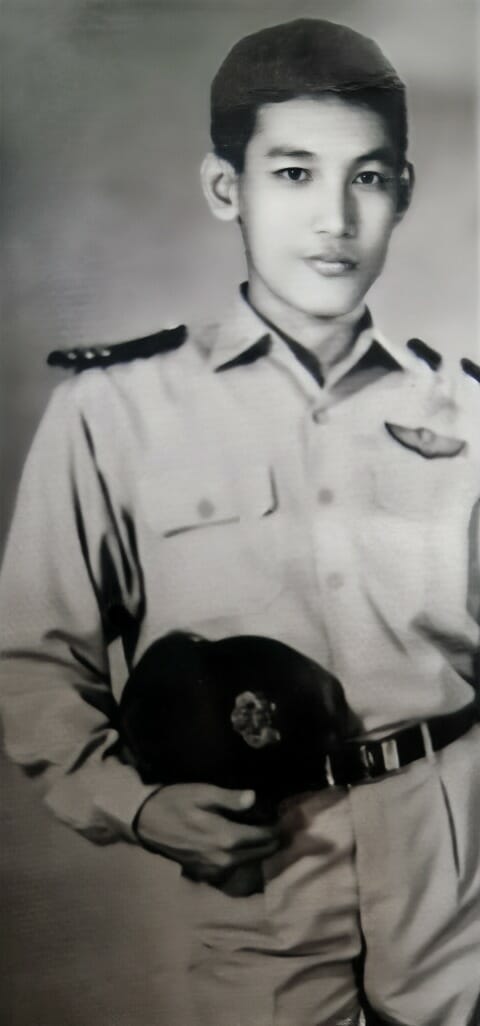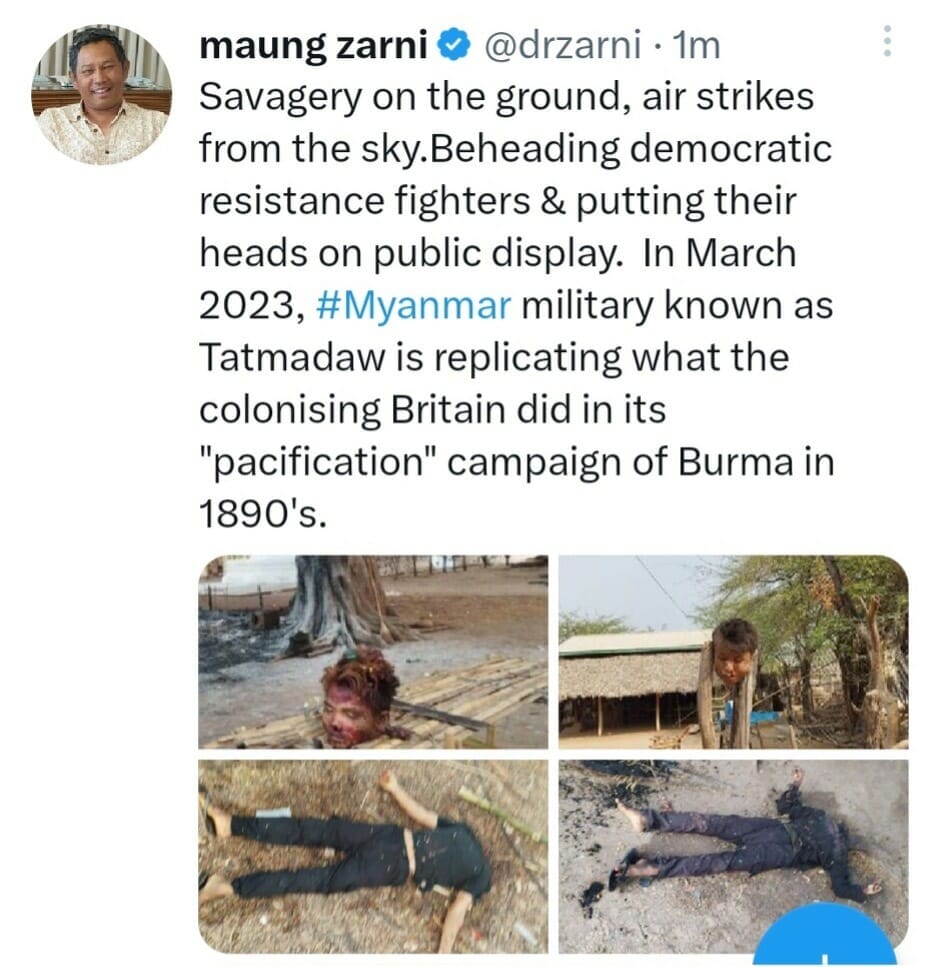I wanted to be a fighter-pilot as a young boy from one of the extended old military families of Mandalay. And my late uncle whom I was very fond of, served in the Burma Air Force (BAF) in his entire military career. And now almost 60, I want the very same force to be designated as a terrorist organization by ASEAN, and internationally.

My late uncle, Captain Hpone Maung, Burma Air Force, Rangoon (Circa. 1970)
I grew up in the Burmese nationalist heartland. “Naturally,” my consciousness was nurtured on my mother’s heroic family tales of her close male relatives who fought WWII Japanese fascists, post-independence ethnic insurgencies in the 1950’s and 1960’s and the Chinese-backed local communists in the 1970’s.
My mother’s younger brother named Hpone Maung was a BAF fighter-pilot, and he was my first idol. Interestingly, his real name at birth was Bomb Maung (Mr Bomb). For he was born in a bomb shelter in our ancestral home on the east side of Mandalay’s walled city, on the day when allied fighter jets bombed Mandalay Palace to the ground, which was then occupied by the Japanese Imperial Army troops. He didn’t like his given name. So, he changed it to the smoother-sounding Hpone Maung, my mother would tell me with a chuckle.
In the late 1950’s, as freshers, he and my mother enrolled, at Mandalay University together. But my uncle left the university after 1st year to attend the Defence Services Academy In-Take – 6 – In-takes refers to graduating classes– 40 miles away in May Myo, the old colonial town, built and named after one British colonial officer – Colonel May (or the Town of May). Ex-Captain Win Htein, the now retired policy adviser to the disgraced Myanmar State Counsellor Aung San Suu Kyi, was a good friend of my late uncle, one year senior at the DSA, from In-Take 5.
Two years after the country’s very first military coup of 1962, my uncle graduated with a BS and was commissioned as a Second Lieutenant. And he was very proud that he was the only cadet who was admitted to the Air Force in his graduating class of 30 in 1964. I remember seeing the black and white pictures which my uncle sent home of him, being “winged” by his instructor who later became the Vice-Chief of Staff – Air Force at Meikhtila Air Base, about 90 miles south of my home city.
My mother meanwhile completed her undergraduate studies, started her teaching career as a history teacher, eloped with my father and had me as her first child. Many of my bedtime stories – often told by my mother with sisterly pride – about her brother and his air force experiences, belly-landing in the Shan plateau because of mechanical failure in his aircraft, or flying in the country’s counter-insurgency operations.
I grew up with fondness and admiration for this elite institution of Air Force – not involved in torture or arrest of dissidents – through family tales littered with familiar public names. In a military dictatorship, generals are typically household names. For the military propaganda division makes sure the names and images of generals litter the front pages and TV headlines news.
I remember feeling awe-struck when I first met him in person in his Air Force uniform, in my adolescent years. There were only a tiny number of military officers who became an elite group of fighter pilots. They got special import rations such as chocolate, whisky, in addition to fancy pilot watches and Made-in-USA flight jackets. I told myself that I was going to follow my uncle’s footsteps. “What’s not to like about being a smart-looking pilot?,” I told myself.
I didn’t become a fighter pilot, to belabour the obvious. And the image of my uncle, my boyhood idol, became less inspiring as I got older, although we remained close.
U Maung – as I called him – was chosen to be a VIP pilot – there were 4 in total – for General Ne Win, the coup leader and commander-in-chief of Myanmar Armed Forces since February 1949, and he first joined the Team A – as it was called – as first officer, under the old British RAF-trained Captain Kyawt Myaing, in the mid-1970’s.
By my high school years in the late 1970’s, Ne Win was already the popularly hated and feared figure. He was the brutal dictator who tortured and locked up student activists, socially engaged monks and leftist intellectuals, for years on end.

Dr Nyi Nyi, (with spectacles seated in the front row), the lone civilian technocrat, among military deputies in General Ne Win’s 1962 military junta, The General Education Seminar, Mandalay University, 1968.
My uncle was Ne Win’s pilot, until the old fox was placed under house arrest by the even more ruthless successor, Dictator Than Shwe, in the late 1990’s.
I often wondered about what my uncle thought of his VIP passenger, but he and I never talked politics whenever I stayed with him in Rangoon. I drank whisky with him, laughed along at his jokes, and listened to his complaints about the military, which he would tell when he got sufficiently tipsy. H would rant about the rottenness of the Burmese military force. He absolutely hated “shit-headed” army peers of his, who typically floated to the top of the military food chain. He wasn’t too happy that smarter and better-educated pilots – like him – were ordered about by the morons in the army.
Neither my mother nor her beloved brother is alive today.
I know for a fact that my late mother would condemn Min Aung Hlaing’s Myanmar Air Force resorting to acts of terrorism from the sky. I also know that my uncle would be even angrier than shittier-headed army generals in Min Aung Hlaing’s inner circle are deploying the Air Force to terrorise unarmed citizens, fleeing ground assaults by ruthless infantry units, in their Fascist-like “pacification” campaigns.
The Myanmar Air Force which I dreamed of serving in as a young boy, is now routinely firing missiles, dropping bombs and shooting from gunship helicopters, all targeting civilians including IDPs.
Two weeks ago, I organized a panel discussion on this very troubling topic of Myanmar Air Force launching air strikes against civilians throughout the country. [FORSEA Dialogue LIVE on our Democratic Struggle Series].
On the 2nd of March, the 61st anniversary of Myanmar’s first military coup of 1962, Associates to Develop Democratic Burma, Inc., run by a group of exiled democrats from Myanmar, who are now based in Canada, released their well-researched report on how my late uncle’s beloved Air Force has been terrorising civilians including war-fleeing IDPs (local refugees) on the ground.
https://t.co/9BAp9aKV1t “Myanmar military leadership have, with alarming frequency, deployed fighter jets, helicopter gunships and artillery to strike civilian targets including Christian churches, Buddhist monasteries, schools, clinics and hospitals.”
— FORSEA (@officialFORSEA) March 3, 2023
Full report: Myanmar Air Force targets civilians, clinics and schools (dhakatribune.com)
Concurrently, Myanmar Army units are engaged in the savagery of beheading young democrats who actively resist Min Aung Hlaing’s coup regime from reasserting its control over the populations throughout the country, that are no longer prepared to live under the boot.

Screenshot of an earlier tweet from Maung Zarni @drzarni which has since been taken down.
Under Min Aung Hlaing’s genocidal commandership, Myanmar Armed Forces are morphing into a terrorist organization in full view of the world at large.
The question now for Myanmar – and pro-democratic world – to ask themselves is a variation of Lenin’s “What needs to be done?”
The ADDB report (see below) on the air strikes against Myanmar civilians offer some sensible policy recommendations.
Maung Zarni
Read ANADOLU REPORTING: ASEAN urged to end ‘security cooperation’ with Myanmar junta

